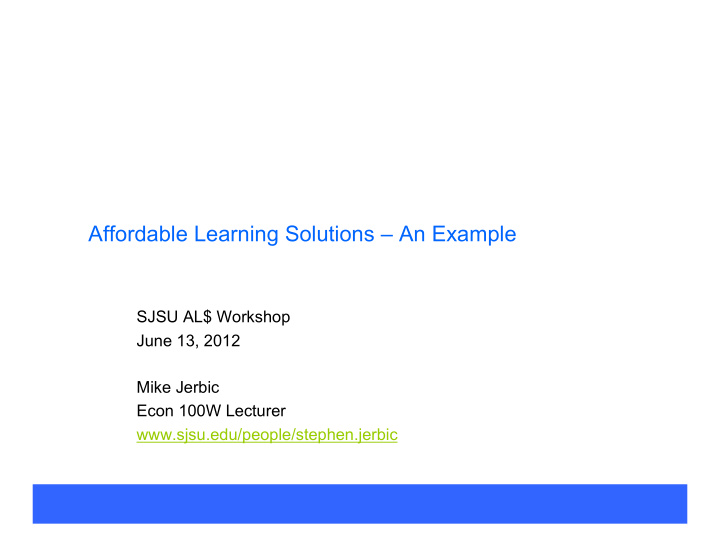



Affordable Learning Solutions – An Example SJSU AL$ Workshop June 13, 2012 Mike Jerbic Econ 100W Lecturer www.sjsu.edu/people/stephen.jerbic
From Last Time • Students appeared to accept $75/course as reasonable and appropriate for class books and materials • Students willing to trade “quality” for price. Some students won’t buy anything • Products usability varied and could become unwieldy – Licensing terms, rental/renewal periods, technology incompatibilities, technology duplication and overlap leading to costs of managing complexity • Using these materials requires a willingness to innovate
Presentation Objectives • How I assess materials: selection criteria • Example of my choices for affordable learning resources • Example from last semester’s pilot • Lessons learned, warnings, recommendations to you Improve student reasoning and expression skills within an economics perspective or point of view.
Resource Selection Criteria • Cost: Total student material cost not to exceed $75 – Rule of thumb from last time • Quality: Good enough to accomplish my purposes. – Contains material I need to teach or exemplify – Minimal cost to me – Nice to have: flexibility to customize, range of options • Schedule/availability – Available before class, in enough time for me to review in the summer – If “free,” on the web, no access controls to material, I consider material effectively in the public domain and can refer students to it • Meets requirements of – Students – Academics – Industry decision making
“Free Stuff” That Supported a Class Project • Articles from the New York Times , Economist, other publications • PG&E Website for electricity rates, responses to regulatory agency actions • CA CPUC, CEC website for electricity policy and decisions • SSRN for articles – Some from Harvard University – Some from commercial, for-profit consulting firm – Law journal articles • TED-talks, You-Tube, podcasts – Follow links from above if useful • Online Purdue OWL resource • Local Industry association chapter meetings • Industry standard publications/materials
“Free Stuff” from Last Semester
My Last Econ 100W Class $12 in print, $40-129 print $35-45 in print, $6-7 in print, $10 in Kindle $0-35 digital $28 in Kindle $5 in Kindle $17 to e-rent www.wikisource.org My own slides! “The Art of Being Right” by Arthur Schopenhauer $0
Pilot I Ran Last Semester • Purpose: Determine whether I should this book next semester to provide reference resources in remedial grammar • Student Assignment: Optional extra credit points to use and review selected chapters in this book • Required a short essay on • how the student used the book • how it impacted writing • how I should teach it • whether it was worth $25 digital price • whether I should use it next semester • 23 signed up to do this extra credit, 13 delivered a paper
Pilot Results • No answers to exercises in book. Needed answers to check work • Students would read online through Flatworld Knowledge’s online web reader rather than pay money for portable e-book or printed book. Worth $25 only if the free online version unavailable • One student who had a free access to ebook preferred online book • Student’s don’t generally own e-readers. They use smartphones and laptops exclusively • Preferred book to Purdue’s OWL • Use in the beginning of the semester
Take-Aways • Material prices vary widely – you may need to work to find out the full range of options. Publishers offerings change • From my pilot, students choose the version readable on a full-up computer or smartphone. Student’s don’t use e-readers yet. • Anticipate functional problems with e-readers and e-books. Verify combinations of e-books and e-readers you recommend to your students • Negotiate with content providers to make resources more affordable • I will have to develop my own presentation/instructional materials • Pilot provided enough information to use the FWK book next semester • Students don’t see value in outside the classroom opportunities (at least not the ones I organize!)
Warnings • Instructor materials may be weak. Check them carefully or commit to making them yourself • Students require incentives to experiment with you outside of the classroom • “Free stuff” requires a lot of your time to select, structure, and use. Results may not cohere • Technology may have bugs, and students will likely choose least cost alternative. • Articulate the least cost alternative that is sufficient for you. You don’t have to accept the “free” version necessarily
Recommendations to You: Be Willing to Innovate • Give yourself permission to experiment • Involve students – be honest with them regarding your purpose, methods, reasoning • Give incentives to help you – they won’t help you for free • Ask publishers, technology providers for help when you see problems. Be willing to articulate problems, follow through. • Negotiate pricing alternatives with publishers • Expect weak supporting materials that you’ll have to supplement • Post slides you present
Questions
Recommend
More recommend